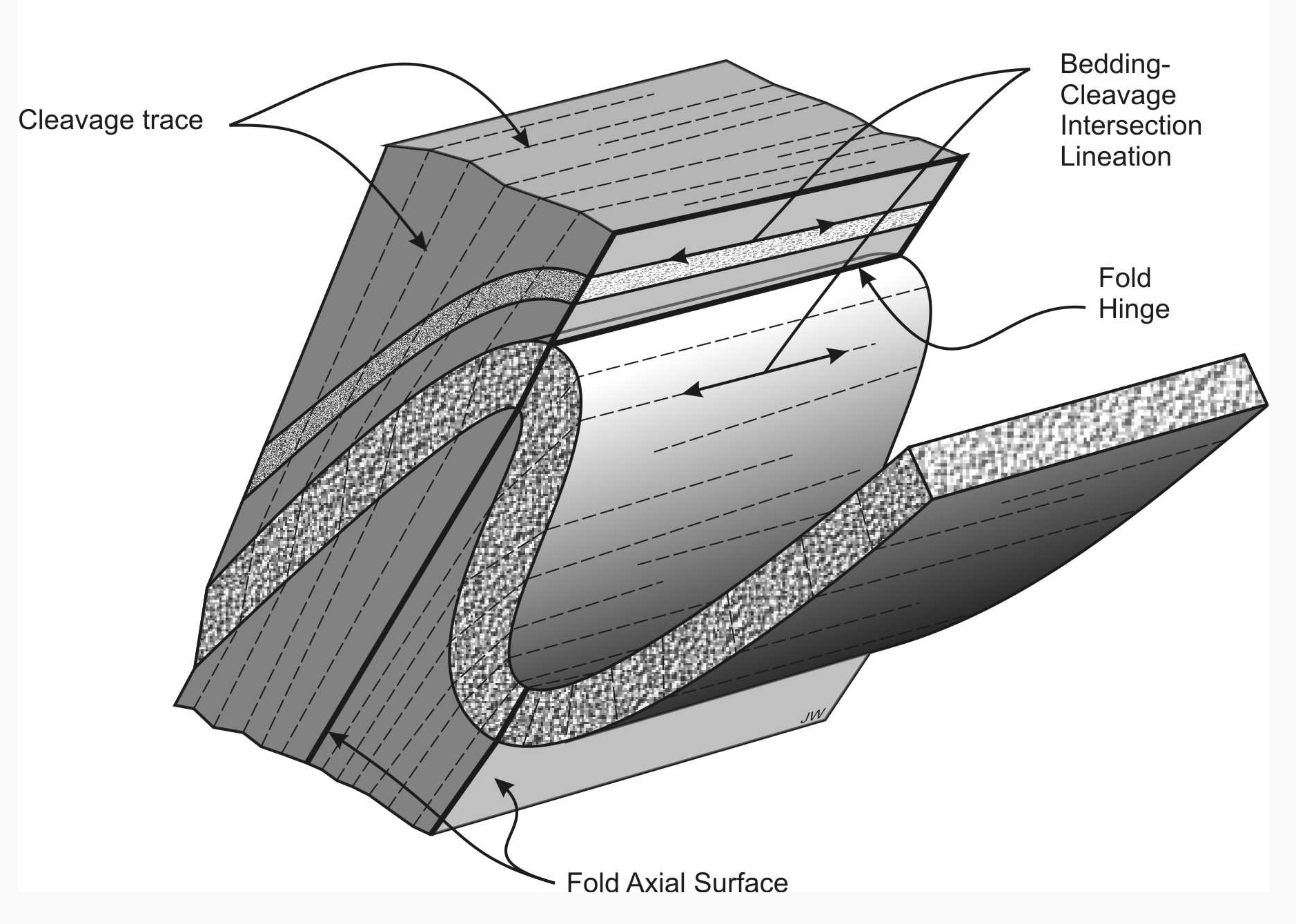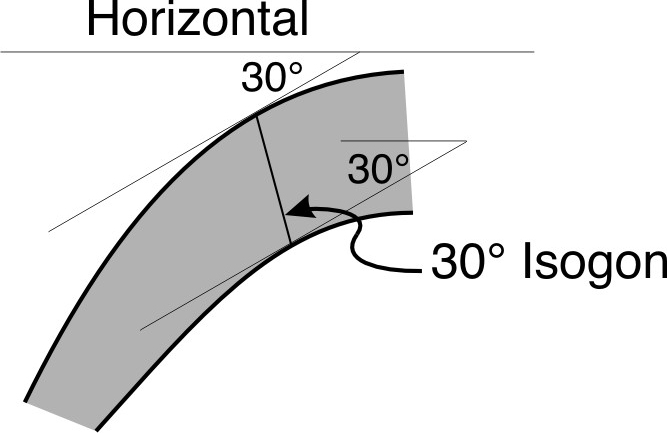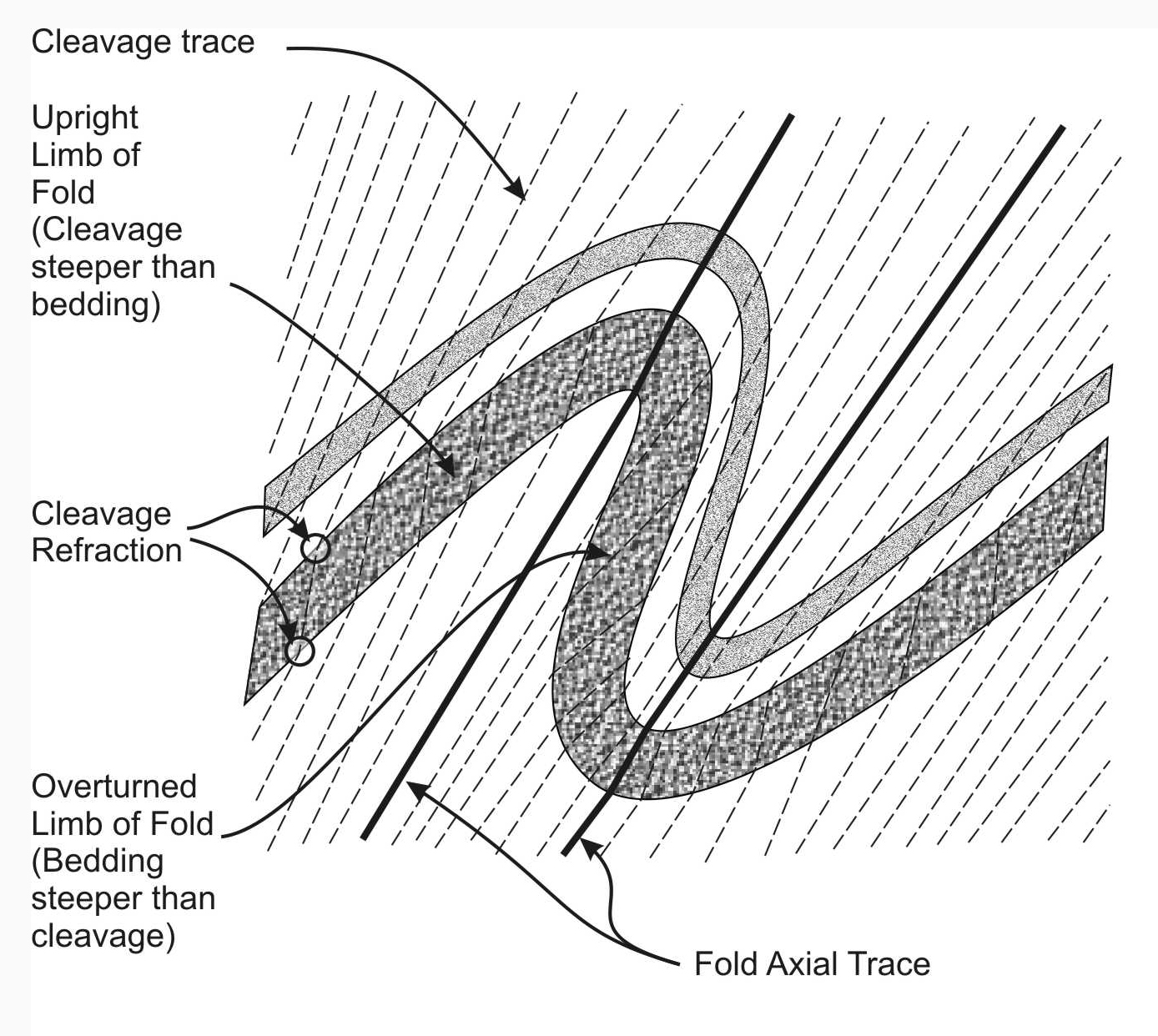
This is a very large and diverse category as metamorphic rocks of all types are widespread in orogens. Much of our understanding of metamorphic belts is derived from metamorphic petrology, which allows us to determine information about the temperature and mean stress (a.k.a. pressure) under which metamorphic minerals formed. These techniques will be familiar to some members of this course but not all. In this unit we will take pressure and temperature as given, and focus on the deformation features, which are mainly produced by the history of deviatoric stress acting on the rocks during their metamorphic recrystallization.
Belts dominated by slate and other low-grade metamophosed sedimentary and volcanic rocks are found in many orogens. They seem to come from a variety of tectonic settings, e.g.:
Cleavage is the fabric that defines slate. Originally, slaty cleavage was defined as a planar fabric that is totally penetrative.
However, under high magnification, most cleavages are domainal at some scale; in other words its possible to see between the cleavage planes.
In bedded rocks, slaty cleavage is almost always associated with a bedding-cleavage intersection lineation, parallel to fold hinges.

Sometimes there is also a faint mineral lineation on the cleavage surface, which is known as a down-dip lineation, from its most common orientation.
The origin of cleavage has been the subject of some controversy. In particular, in some cases cleavage planes have been regarded as planes of shear, whereas other examples have been interpreted as planes of flattening.
To answer this question we need to look at strain markers in cleaved rocks. The overwhelming conclusion is that cleavage planes are usually very close to the S1S2 (or XY) plane, and therefore perpendicular to S3 (or Z) the direction of maximum shortening.
"Down-dip" lineations, where present, are probably stretching lineations, parallel to S1 (X).
How does shortening produce cleavage? More than one process contributes:
Clasts, burrows, fossils, etc. can be regarded as domains of one composition surrounded by another. On deformation, these domains become distorted, and a fabric is defined by the distorted domains.
Any strain results in the rotation of lines and planes toward the long axis of the strain ellipsoid and away from the short axis.
Transposition describes the process by which a fabric (usually a planar layering) is separated into portions which are independently rotated into a new orientation.
Pressure solution: Grains are preferentially dissolved at contacts perpendicular to maximum compressive stress, generating a fabric of grain shape.
Pressure solution may also produce a layered fabric.
Where does the dissolved material go? In some rocks it seems to leave the system (maybe ending up in hydrothermal veins or cements higher in the crust.) In other cases, dissolved material may be redistributed within the rock as new mineral growth.
New mineral growth may produce 'pressure shadows' more accurately termed 'strain shadows' on the ends of grains. The new mineral grains may have strong preferred orientation, contributing to fabric
Most slate belts have a proportion of sandstone, varying from zero to 90%. Typically the sandstone layers are more obviously folded, and less obviously cleaved than the mudrocks. By comparing the shapes of the layers we can learn more about the dynamic properties of the rocks during folding.
To investigate the geometry of folds we can use dip isogons - lines joining points of equal dip, to compare the curvature of the inside and outside arcs of folds.
Dip isogon construction:


Sandstone layers typically show rounded folds with class 1 geometry, with tighter curvature on the inside of the folds, known as buckle folds.
Intervening slate layers show class 3 geometry, with tighter curvature on the outside of the folds.
Where sandstone layers are closely spaced, the style tends to be more angular overall. Kink folds have typically 120° interlimb angles; Chevron folds have typically 60° inter-limb angles.
Some fold styles: (a) Parallel folds produced by buckling of strong layers; (b) Similar folds, typical of layers with very low strength contrast; (c) Chevron folds; (d) Kink folds.
The typical fold-cleavage relationship in slate belts is 'axial-planar' with an intersection lineation parallel to the fold hinge.
Commonly cleavage is not everywhere exactly parallel to the axial surface. The most common departure is cleavage refraction. Cleavage planes bend so that they are more nearly perpendicular to layering in more competent layers (e.g. sandstone).

To understand the strain significance of cleavage refraction it is helpful to look at two idealized kinematic models of folding: Both are constructed for ideal parallel folds (class 1B).
Cleavage refraction thus be thought of as the result of varying amounts of pure shear and simple shear relative to bedding planes.
Notice incidentally that the kink construction (which we met in balancing cross-sections) implies that layers deform by flexural slip.
Single layers embedded in weak material undergo buckling when subjected to differential stress with the maximum compressive stress nearly parallel to the layers. A deflection nucleates a first wave. This then propagates along the layer.
Theoretical analyses have predicted the wavelength of folds for materials of idealized properties. E.g. for newtonian (viscous) material, the wavelength of a single buckled layer is proportional to layer thickness and to the ratio of the two viscosities.
![]()
Experiments for multiple competent layers show:
Polyphase deformation structures are widespread in the metamorphic cores of orogens, where the rocks involved may include:
In contrast to folds in slate belts (where there is usually a clear distinction between competent layers with class 1 geometry and incompetent layers with class 3 geometry) folds in higher-grade metamorphic rocks often show geometries close to class 2 - similar folds.
How do these folds originate?
One obvious mechanism is heterogeneous simple shear, in which case the axial planar fabric surfaces would be shear planes. This conflicts with what we know of the kinmematics of fabric development. Close examination typically reveals that in fact there are class 1C layers, alternating with class 3 layers. This suggests a much more likely kinematic scenario. Initally these folds probably result from buckling, similar to that observed in slate belts. Then a pure strain (or other homogenous high strain) is superimposed on the rocks at high temperature, under conditions where competence contrast is lower.
Fabrics in metamorphic rocks are typically defined by coarse-grained minerals that grew during metamorphism. It is common to observe a first fabric that is parallel to the compositional layering of the rock. This can arise by
Both processes may occur together.
To unravel the structural history of polyphase deformation we look for:
Based on these types of relationships we typically number the generations of folds and fabrics in a given area using a numerical scheme. Fold generations in this scheme are numbered F1 F2 F3 etc. The corresponding foliations are S1, S2, S3 etc, where S2 is the foliation that is axial planar to F2 etc.
Corresponding lineations are numbered L1, L2 etc.
(Note that there may be more than one lineation associated with a generation of structures. For interest, if you are working with complex structures, here are some additional notes on handling multiple lineations that are part of a single generation of structures)
Areas affected by multiple episodes of folding may display refolded folds in a bewildering variety of orientations. To make sense of these we use a classification (devised, like many other fundamental classifications of folds by J. Ramsay). This classification relates to two generations of folds only - if we have 3 or more generations things get more complicated.
In each case we characterize a first generation of folds by
Later folding does not bend either the axial surfaces or the hinges of early folds. The early folds are just tightened during the second phase of deformation.
Later shortening is roughly parallel to the hinges of the early folds, and later extension direction lies in the early fold axial surfaces. Hinges of the early folds are bent but not the axial surfaces. Oval outcrop patterns of layer traces on outcrop surfaces.
Later shortening is roughly parallel to the hinges of the early folds but extension at a high angle to the early axial surfaces. Fist generation hinges and axial surfaces are refolded. Outcrop patterns characterized by complex mushrooms and banana shapes.
Second-generation shortening direction at a high angle to the early fold hinges and the extension direction is at a high angle to the early axial surfaces. Early hinges remain more or less straight but early axial surfaces are folded. The trace of layering typically follows a multiple zigzag shape.
To analyse an overprinted fold pattern, the most important first step is to draw axial traces on an image of the outcrop. In general, the latest set of axial traces is likely to be approximately straight. Earlier axial traces may or may not be folded. (In general, type 1 interference patterns, where early axial surfaces are not folded, are the most difficult to analyse; it may not be possible to determine the order of folding.)
(Note: This material is covered in EAS 332 Metamorphic petrology and may be omitted this year to save time.)
Metamorphism is often concurrent with deformation and new mineral growth can often be related to polyphase deformation.
Porphyroblasts of garnet, staurolite etc may be much more rigid than their matrix. Hence we can recognize
Synkinematic porphyroblasts may show complex inclusion trails
Note: there have been big controversies over whether helicitic structure has been produced by:
(Note: This material is covered in EAS 332 Metamorphic petrology and may be omitted this year to save time.)
Metamorphic petrologists use metamorphic reactions to produce P-T-t paths. By integrating information on fabric development with the timing of growth of metamorphic minerals and isotopic dating, it's sometimes possible to develop quite detailed knowledge of D-P-T-t paths (Deformation - Pressure - Temperature -time).
These paths are described as 'clockwise' or 'counterclockwise' based on their appearance on a graph of P against T. Unfortunately, there are two ways of doing this: with pressure plotted increasing upward, or with pressure increasing downward (as it does in the real Earth). Most researchers in tectonics prefer the upward style, so a path that increases pressure early, and then increases temperature, is typically described as 'clockwise'.
Blueschists and other high pressure - low temperature metamorphic rocks almost always show clockwise paths in PT space. This is because rapid burial is necessary to produce high P; if cold rocks remain at depth for any time, they start to warm up. To be preserved without completely overprinting the high P low T features, they have to be exhumed rapidly, but the metamorphic history nonetheless shows some of this warming.
Because we find metamorphic rocks, with mineral assemblages indicative of high pressure, at the Earth's surface, there must be a mechanism to bring them there. In general, we can envisage two end-member processes responsible for this exumation of rocks in orogens: rock is either removed by erosion, or is removed tectonically by extension. In many orogens, both processes are known to have occurred
Although uplift is often cited as the reason for exposure of deeply-buried rocks in orogens, but erosion is critically important too. For example, rocks recording burial depths of 20 km or more are commonly found at the tops of 5 km high mountains. Imagine uplift acting alone on such rocks after their formation. 20 km of uplift would produce a mountain range 20 km high - which does not occur. (The highest mountains are only ~9 km above sea level.) So if we find rocks from 20 km below the surface at the top of a 5 km mountain, that requires 20 km of uplift and 15 km of erosion. So, the elevation of mountains is the result of exhumation - a combination of uplift and erosion - in which uplift has often only slightly exceeded erosion.
Consider now the kinematics and dynamics of exhumation. The stress on a body of rock undergoing exumation may be partly a result of the convergence of plates, but it is also moderated by the erosion of overlying rock. Erosion, in combination with isostasy, acts to bring high-pressure metamorphic rocks to the surface. Thus it has been demonstrated that rates of erosion are particularly rapid (where, for example one part of an orogen is subject to monsoon rains) high-pressure metamorphic rocks are more likely to reach the surface. This has been particularly demonstrated in the case of the Southern Alps of New Zealand, where one side of the mountain range is subject to much higher rainfall than the other, because of prevaling winds.
The Himalayas are also a product of large-scale continental collision, between India and Eurasia. This time the northern plate over-rode the southern.
This collision has thickened the crust beneath the Tibetan plateau to approximately double the Himalayan thickness.
There are two end-member models for this thickening. In one model it is accounted for by thickening of the Eurasian margin (an approximately pure-shear model). At the other extreme is a model in which the Indian crust extends beneath the Eurasian crust as far as the north edge of the plateaue. Think of this as a simple shear model.
Deformation in the Himalayas is not a simple matter of convergence. Studies on kinematic indicators in metamorphic rocks and granitoids show that a sheet of high grade metamorphic rocks in the High Himalayan crystalline zone is bounded above by a normal fault, the south Tibetan detachment zone. Deformation and exhumation of these rocks occurred while granites were being intruded.
This leads to the idea that these rocks were weakened by partial melting, causing them to lose the wedge-shape (critical taper) that characterize thrust belts and spread laterally. This type of behaviour has been called channel flow.
As in the Alps, later stages in deformation have been marked by major strike-slip faults, suggesting that blocks of continental crust are escaping laterally from the zone of intense collision. In addition there are north-south graben cutting the Tibetan plateau that may also reflect lateral extrusion of crust.
Normal faults are also prominent in the later history of the North American Cordillera. A large area of the western US shows basin and range geomorphology defined by numerous normal faults. VDPM 16.12
Diagrams showing multiple intersecting normal faults
It's clear that some faults formed in flat orientation, and outline large areas of deep-crustal metamorphic rocks from which the cover has been removed by a combination of tectonism and erosion - core complexes.
VDPM 16.13 cross-section of core complex
The faults surrounding core complexes are typically hybrid brittle-ductile structures, with fault breccia in the hanging wall and mylonite in the footwall.
These features suggest that these extensional zones are dominated by listric faults that flatten into a detachment close to the brittle-ductile transition.
In other parts of the orogen, including the southern Canadian Cordillera, there are core complexes that appear to be older equivalents of the basin and range.
Why core complexes? Several hypotheses have been suggested:
All these factors have affected the Cordillera -the abundance of extensional structures late in orogen history may be due to a combination of factors.